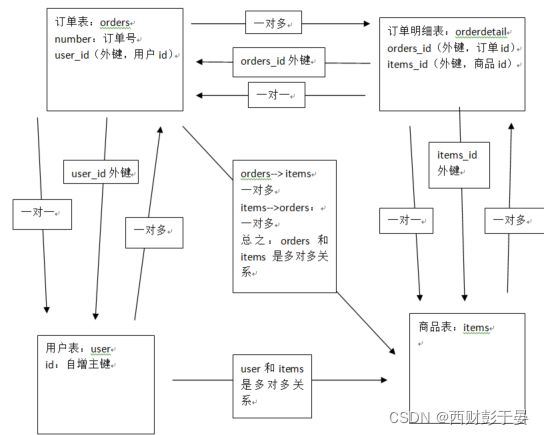mybatis高级映射
mybatis高级映射
- 订单数据模型分析思路
- 一对一映射
- 一对多映射
- 多对多映射
- resultMap和ResultType
-
- resultType
- resultMap
- 延时加载
高级映射本质来说是多个表的联合查询的过程。
订单数据模型分析思路
数据表:
用户表user:记录了购买商品的用户信息。
订单表orders:记录了用户所创建的订单(购买商品的订单)
订单明细表orderdetail:记录了订单的详细信息即购买商品的信息。
商品表items:记录了商品信息。
数据模型分析:

表与表之间的业务关系
user和orders:(一对多关系)
user->orders:一个用户可以创建多个订单,一对多。
orders->user:一个订单只能由一个用户创建,一对一。
orders和orderdetail:(一对多关系)
orders->orderdetail:一个订单可以包括多个订单明细 一对多。
orderdetail->orders:一个订单明细只能包括在一个订单中 一对一。
一对一映射
需求:通过订单号来查询订单及用户信息
select * from orders o,user u where o.user_id = u.id and u.number=?
分析:通过分析,orders表示主表,user表是辅助表
在Order的pojo类上添加上User属性
public class Orders213 {
private Integer id;
private Integer userId;
private String number;
private Date createTime;
private String note;
//新增属性
private User213 user;
//省略了getter和setter方法
}
接口方法:
Orders213 selectOrdersByNumber(String number);
返回结果通过resultType返回:
<select id="selectOrdersByNumber" parameterType="string" resultType="com.tulun.Mybatis.pojo.Orders213">
select o.*,u.id "user.id",u.username "user.username",u.sex "user.sex",u.address "user.address" from orders o,user u where o.user_id = u.id and o.number= #{number}
</select>
使用resultMap配置一对一映射:
<resultMap id="orderUserMap" type="com.tulun.Mybatis.pojo.Orders213">
<id property="id" column="id"/>
<result property="userId" column="user_id"/>
<result property="number" column="number"/>
<result property="createTime" column="createtime"/>
<result property="note" column="note"/>
<!--user属性配置-->
<result property="user.id" column="u_id"/>
<result property="user.username" column="u_username"/>
<result property="user.sex" column="u_sex"/>
<result property="user.address" column="u_address"/>
</resultMap>
<select id="selectOrdersByNumber" parameterType="string" resultMap="orderUserMap">
select o.*,u.id u_id,u.username u_username,u.sex u_sex,u.address u_address from orders o,user u where o.user_id = u.id and o.number= #{number}
</select>
使用resultMap中提供的association配置一对一关系。
association:用于配置关联查询的单个对象。
property属性:要映射到pojo类中的对象的属性。
javaType:要映射的pojo属性的全限定名。
columnPrefix:针对数据库相同前缀的别名。
<resultMap id="orderUserMap1" type="com.tulun.Mybatis.pojo.Orders213">
<id property="id" column="id"/>
<result property="userId" column="user_id"/>
<result property="number" column="number"/>
<result property="createTime" column="createtime"/>
<result property="note" column="note"/>
<association property="user" columnPrefix="u_" javaType="com.tulun.Mybatis.pojo.User213">
<result property="id" column="id"/>
<result property="username" column="username"/>
<result property="sex" column="sex"/>
<result property="address" column="address"/>
</association>
</resultMap>
优化2:
extends继承自主类,resultMap使用一个已经存在的map类
<resultMap id="orderUserMap2" extends="orderMap" type="com.tulun.Mybatis.pojo.Orders213">
<association property="user" columnPrefix="u_" resultMap="com.tulun.Mybatis.mapper.User213Mapper.userMap"/>
</resultMap>
注:一对一映射使用resultMap下的association来配置映射关系。
一对多映射
将关联的列映射为list。
需求:查询用户的订单信息
select * from user u,orders o where u.id=o.user_id and u.id=?
分析:通过用户id查询用户订单信息,用户在user表,称为主表,关联的是orders订单表,订单表是辅助表。
使用resultMap下提供的Collection配置来配置一对多关系。
映射pojo类配置:
public class User213 {
private Integer id;
private String username;
private String sex;
private String address;
//添加orders属性
private List<Orders213> orders;
//省略getter和setter方法
}
配置文件:
<resultMap id="userMap" type="com.tulun.Mybatis.pojo.User213">
<id property="id" column="id"/>
<result property="username" column="username"/>
<result property="sex" column="sex"/>
<result property="address" column="address"/>
<collection property="orders" ofType="com.tulun.Mybatis.pojo.Orders213" columnPrefix="o_" >
<id property="id" column="id"/>
<result property="userId" column="user_id"/>
<result property="number" column="number"/>
<result property="createTime" column="createtime"/>
<result property="note" column="note"/>
</collection>
</resultMap>
<select id="selectUserById" parameterType="int" resultMap="userMap">
select u.*,o.id o_id,o.user_id o_user_id,o.number o_number
,o.createtime o_createtime,o.note o_note
from user u,orders o where u.id=o.user_id and u.id = #{id}
</select>
使用resultMap标签下提供的Collection配置一对一关系。
collection:对关联查询到的多条记录映射到集合对象中。
property属性:将关联查询到的多条记录映射到orders属性中。
ofType属性:指定映射的集合属性中的类型全限定名。
多对多映射
需求:查询用户及用户的商品信息。
分析:查询用户是主表:user表,关联表,订单orders表,订单明细orderdetails表和商品表items。
将结果映射到user属性中,在user类上添加订单列表属性List ,将用户创建的额订单映射到orderlist中。
在orders添加订单明细列表属性List,将订单明细映射到OrderDetails中。
在OrderDetails类中添加商品属性Item类型,将商品映射到item上。
resultMap和ResultType
resultType
将数据库中的数据映射到pojo类上,自动将字段完成映射,减少映射编码,对于数据库字段和pojo属性不一致时是无法完成字段映射,如果所有字段都不匹配,则无法映射pojo对象出来。
1、映射自动化,如果字段较少且保保持一致优先选择resultType。
2、对于多表映射,只能进行一对一映射。
resultMap
resultmap是手动显性实现映射,是可以处理数据库字段和pojo类字段不一致的问题。
还可以使用association和Collection完成一对一和一对多高级映射。
association:
作用:将关联的查询信息映射到一个pojo类中。
Collection:
将关联的查询信息映射到一个list集合中。
延时加载
延时加载的配置
默认为开启延时加载,需要在配置文件中给定延时加载配置setting。

<settings>
<setting name="lazyLoadingEnabled" value="true"/>
<setting name="aggressiveLazyLoading" value="false"/>
</settings>
延时加载主要针对的是关联表的查询,属于高级映射(使用association和Collection来具备延时加载功能)。
延时加载在association和Collection都有select属性:指定延时加载需要执行的StatementID。
<resultMap id="orderUserMap3" extends="orderMap" type="com.tulun.Mybatis.pojo.Orders213">
<association property="user" column="id={user_id}" select="com.tulun.Mybatis.mapper.User213Mapper.selectUserById"/>
</resultMap>
<select id="selectOrdersByNumber" parameterType="string" resultMap="orderUserMap3">
select * from orders where number = #{number}
</select>